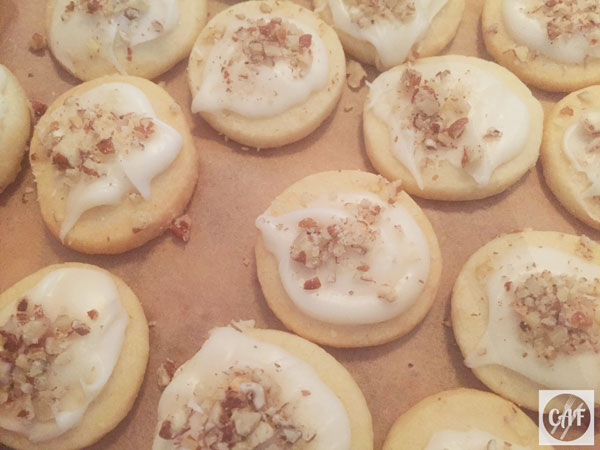[laughter and applause]
No, but really. I was having memories of all the dear, little, old ladies at my church who used to make this amazing smorgasbord of cookies unlike anything I'd ever seen in my life. The cookies were for a gathering after our church's annual Christmas talent show, a show where Mrs. Wilson always read the "12 Days of Christmas" love-letter series (HYSTERICAL; it was largely her reading of them that made them so). I always attempted to pound out a song on the piano, usually becoming so shy that I just went back to my pew and didn't play; and Mr. Hammaker, I think it was, would always play a song or two on his harmonica. It was an event that I looked forward to every year as a child, and the cookies—the cookies were a huge part of why. Screw dreams of sugar plums. My little head was full of my old ladies' cookies.
I cannot even begin to recall the names of the creations that covered those tables in my church basement, but I can still envision them: snowy meringues that shattered then dissolved into magical, sweet nothingness in your mouth. Mini wreaths, gooey-yet-crispity, dyed brilliantly green then dotted with cinnamon candies. Buttery sugar cookies with little dollops of ruby jam. Chocolate pinwheels. Tiny logs rolled in nuts. And then there were the spritz cookies.
These little guys were oddly my favorite. Small, unassuming but ADORBS. They were made from a simple butter and sugar dough that was pressed through a disc of a particular design and then baked. Christmas trees. Hearts. Snowflakes. Stars. They were so simple. Naked, without any glitz or glamor. They were dyed some delightfully obnoxious colors, though—a thrill that only kids can understand. I loved them.
Fast forward to about five years ago when I found an old cookie press at Goodwill...
And now fast forward to yesterday, with me digging out the old press, the gel food dye, and the KitchenAid. I was on a mission.
Not only are spritz cookies delish, they are so fast and so easy. Seriously. You can crank out a good five dozen cookies in no time flat. In the middle of my making them, I was inspired to share them with you, so I snapped a few pictures and took a few iPhone videos. Don't laugh. They aren't the best quality; but I think you will get a picture of why they are just so awesome. Need tons of Christmas cookies for school or church? Here you go!
The press itself has changed over time. I now see them in the form of a gun. I don't have that one nor have I ever used one. I'm assuming that it perfectly portions out the dough, which would be nice, but I have to assume that the angle would be quite uncomfortable after a single batch of squeezing out dough.
The old press, as you can (kind-of, not really) see in the picture below, is simply a tube fitted with a pressing plate which is attached to a threaded rod which is attached to a knob. It has a detachable cap that holds an exchangeable design plate. Here I've obviously used the tree plate:
To fill the tube, you remove the cap; "unscrew" the pressing plate so that it backs out of and "opens" the tube; fill the tube with dough; then screw the cap (with the design plate attached) back onto the tube. You give a few twists to the knob to get the plate to start pushing the dough—and you are ready to twist out your cookies.
Here's a picture of the tube filled with dough:
Here I have attached the desired design plate inside the cap (drop it in and twist it to lock it into place) and screwed the cap onto the tube.
Here is a short video showing how I twist the knob to get the dough press started, then how the cookies squeeze out as I turn the knob. I only turn mine about a quarter turn for each cookie.
You can see how easy it is! The cookie sheets are ungreased, so the sticky dough just glues itself to the metal. For the rare time when it does want to lift off and doesn't stick, you can see that I just placed the press back on the sheet, gave another tiny turn of the knob, and it stuck!
Ready for some massive quantities of Christmas baking? The spritz is it! Speed bake away! The recipe is easily found online. I got mine from the old Wisconsin Electric Company Christmas Cooky Cookbook. You can find their 2016 copy as a PDF file here. The Christmas Wreath cookie recipe listed uses a similar base dough that I used; however, I (obviously) did not make or use the pecan filling or the candied cherries, though. I just did plain and simple.
Have a wonderful time in the kitchen, folks, and Merry Christmas to you all!







